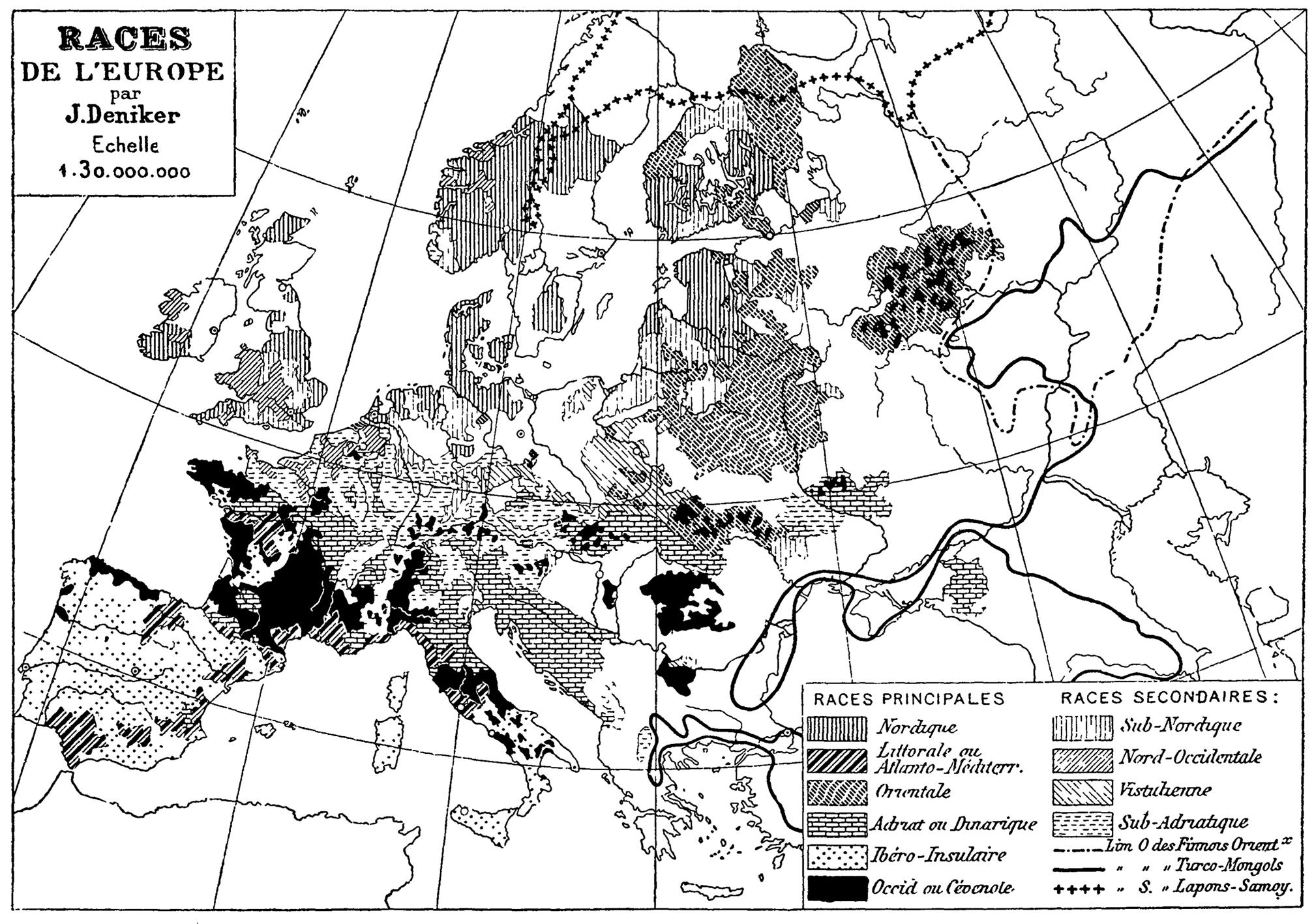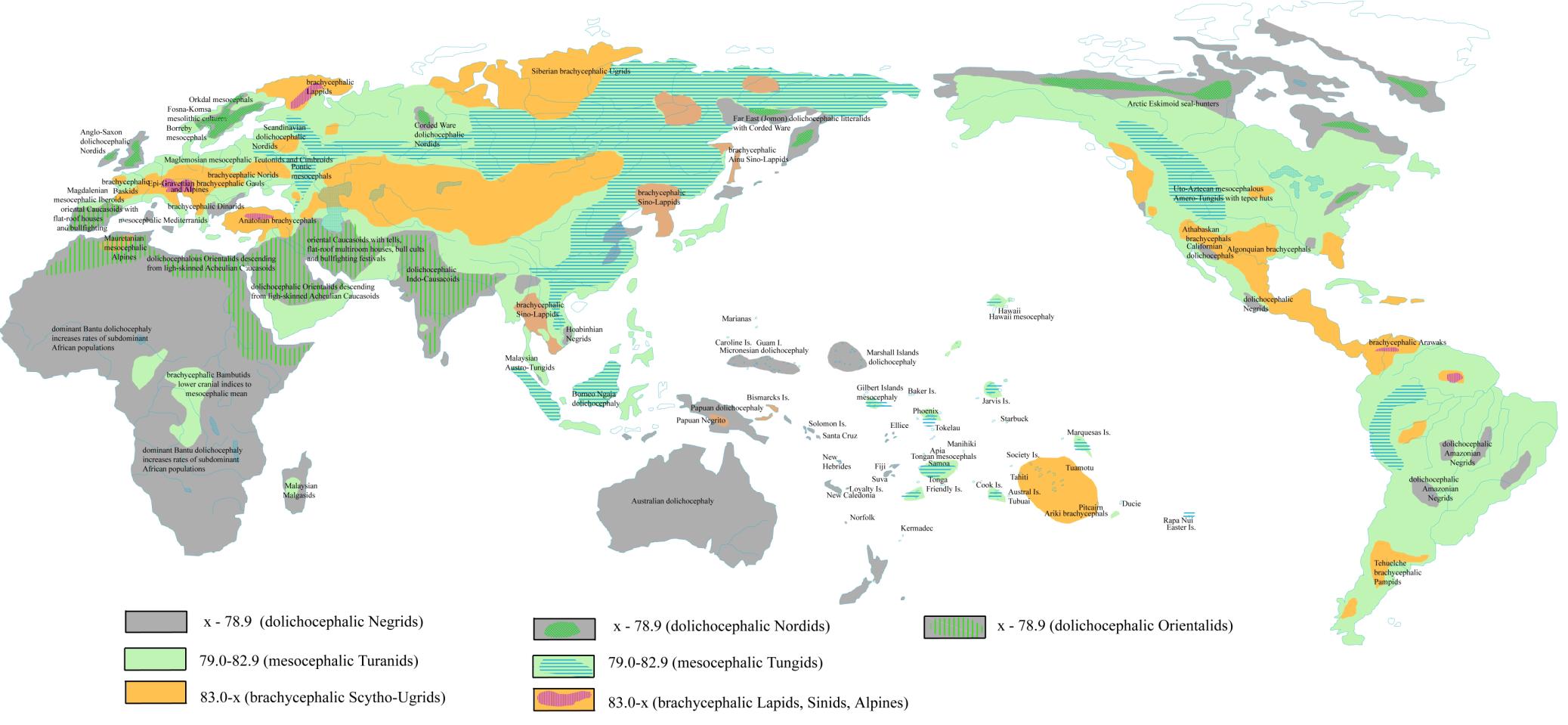|
|
|
|||||||||||||||
|
|
|
|||||||||||||||
|
|
|
|
||||||||||||||
|
|
|
|
||||||||||||||
|
|
|
|
||||||||||||||
|
|
|
|||||||||||||||
|
|
|
|
|
|
||||||||||||
|
|
The Anthropology of Nordids and Europids Clickable terms are red on the yellow background |
|
|
|||||||||||||
|
Map 1. J.
Deniker’s map of nordique , sub-nordique and littorale race |
||||||||||||||||||||||||||||||||||||||||||||||||
|
Map 2. The
worldwide distribution of cephalic indices (after Biasutti) |
||||||||||||||||||||||||||||||||||||||||||||||||
|
|
Nordids
and Europids: The Family-Tree of Agrarian tribes
The language identity of Indo-European
peasants can be detected according to the simple i-a-u vocalism, rich
vocalic quantity and a series of two-mora or three-mora falling diphthongs ai
→ ē, au → ō, which was suitable for hymns in
quantitative prosody. It operated in Old Gothic and Ancient Greek but also in
Old Indian and Classic Arabic as it was the common heritage of the Neolithic
Europoid and Caucasoid peasantry. Later assaults of Asiatic herdsmen
subjected peasantry to serfdom and suppressed their quantitative hymnology by
the predominance of rhymed or alliterative syllabo-tonic epic.
Table 28. The family-tree of axe-tool
cultures Close kinship between European, Anatolian, Mesopotamian and Caucasian
agriculturalists is proved also by their genetic family-trees that stem from
the archaic Y DNA haplogroup IJ. Its haplotype is ancestor to the three
ethnic and cultural complexes: the Caucasoid populations with the type
J-P209, the Danubian farmers with the Linear Ware pottery (Linearbandkeramic)
and the genetic Y DNA haplotype I2-M438 and the Scandinavian Corded Ware with
the haplogroup I1-M253. Their complexes can be recognised also according to
the morphology of housing types. Their earliest archetype indicates a large
rectangular collective longhouse that is compatible with the Amazonian
peasants’ maloca and dwellings of Melanesian agriculturalists (Y DNA
haplogroup M-P256). Comparison to Melanesian peoples is of great import as
the IJ and IJK-L15 haplogroups are genetically interrelated with the Melanesian
haplotype M-L15. In the Neolithic the rectangular longhouses fell into three
special subtypes. The Anatolian and Mesopotamian Caucasoids inhabited
multi-cellular labyrinths in tell-mound sites and rectangular
flat-roofed houses made from rammed clay pisé. The Danubian Linear
Ware people lived in rectangular longhouses with monopitched roofs in fertile
riverside valleys, while the Scandinavian Nordics adhered to archaic
three-aisled terps with A-frame roofs on seaside dunes. Table 28 sums up contemporary
doctrines of genetic Y DNA haplogroup relations of human axe-tool cultures.
It includes also corresponding palaeo-anthropological varieties of man but it
ballots for earlier dating. It attempts to incorporate its clades into the
more reliable framework of radiocarbon periodisation acknowledged as valid in
modern archaeology. It takes over Wolpoff and Caspari’s model2 of ‘multiregional evolution’ proposed as a readaptation of Franz Weidenreich’s Polycentric
Theory (Table 29). It argues that it is untimely to bury descendants of Homo
erectus and Homo neanderthalensis as extinct races because their pebble-stone
cobbled choppers and leaf-shaped lance-heads enjoyed abundant continuance
till the Neolithic horizon.
Table
29. Franz
Weidenreich’s Polycentric Theory
Table 30. The cultural paradigm of
Eurasian agrarian axe-tool tribes |
|
The Palaeolithic plant-gatherers and
preagriculturalists launched several worldwide colonisations in course of
time lasting more than one million years. Their axe-tool making cultures
retained dominance in the southern hemisphere and survived in the progeny of
dark-skinned equatorial races with vegetal subsistence. They got accustomed
to tropical climate and developed vegetal economy that finally resulted in
the invention of horticulture and agriculture. A few hosts headed also for
the northern boreal zone and mixed with Asiatic light-skinned carnivorous
hunters. Their racial interbreeding distorted their original language
structure and gave it a hybrid stamp. The long-term exposure to Altaic
flake-tool makers gave rise to mixed Caucasoid and Europoid ethnic
varieties. Anthropologists treat them as extinct
species of one genus Homo although archaeology confirms cultural
continuity. It evokes suspicion that modern aboriginal populations still
conceal perceptible remnants of prehistoric Oldowans, Acheuleans,
Mousterians, Levalloisian and Gravettians. In civilised centres they
underwent rapid technical progress and diluted their cultural identity but in
isolated refuges they preserved original riches. Table 30 shows that despite
remote genetic distances Europoid and Caucasoid peoples share cultural
patterns revealing affiliation compatible with equatorial races. Map 3 let us guess the main directions of
Oldowan migrations. They cannot be judged as an extinct race as their
pebble-stone chopping tools struck roots in colonised territories and
displayed continual occurrence up to late Neolithic times. Their artefacts
were uninterruptedly manufactured by people of the dark-skinned Australoid
and Melanesoid extraction counted as the tropical equatorial race. The most
remarkable residues are dug up in Hoabinhian sumatraliths ranging from Classical palaeoanthropology was exuberant in coining new artificial
labels such as Pithecanthropus and Sinanthropus as if human
ancestral races represented different genera and species inapt of mutual
interbreeding. It is much more recommendable to term the progeny of Homo
erectus and H. habilis as interbreedable
human stocks similar to strains of domestic dogs and admit a long-term
development of their family-trees. All human populations and colonisations
exhibited extensive longevity. The false impression that human races, tribes
and ethnic groups emerged, disappeared and perished in short intervals is due
to the rapid displacements of Germanic tribal military retinues during the grosse
Völkerwanderung. Dogmatic prehistory believed in fast births, transfers
and extinctions of ancient nationalities and did not admit that they
concerned only princelings’ warrior suites and young generations. On the
other hand, the elders kept their settlements for millennia without dramatic
changes.
Table 31. The tripartition of Europoid peasant
tribes An important source of
complementary information appears in tribal ethnonyms revealing the
internal hierarchy of moieties and phratries. Table 31 suggests that the
three major groups of the alleged ‘Germanic tribes’ actually referred to independent
offshoots of one and the same Mesolithic tribe remarkable for macrolithic
industry of Epi-Micoquian hand-axes. One fallacy was that its descendants had
nothing to do with the Germanic, Teutonic and Cimbrian tribes with
microlithic flake-tool industry of Maglemosian provenience. Another false
dogma believed that Indo-Europeans had been a united people encompassing
hundreds of heterogeneous archaeological cultures and tens of incompatible
races. The sole truth is that the three descendants of the Y DNA haplogroup
I-M170 constituted the dominant core of Neolithic European tribal
populations. They united the most populous substratum of tall robust and
dolichocephalous Nordics integrated into the continental exchange of labour
as European peasantry. This core had nothing to do with the ruling
superstratum of Sarmatoids (Aryans, Normans, Italic Marsi,
Hallstatt raiders and Central European Marharii) that controlled
ancient The distribution maps of genetic
haplogroups testify long-range travels of various prehistoric tribes. The
Langobardian settlers of the Danubian Linear Ware spread their row burials (Reihengräber) as far as the Russian Ananino culture (800 BC).
Its leftover is seen in the These
Late Mesolithic cultures signalled the arrival of a sophisticated population
of horticulturalists with axe-tool macrolithic industry, Corded Ware pottery,
kitchen midden waste, shellfish beachcombing and strandloping subsistence.
Their original homeland is sought in sites of the Campignian (10,000 BC) and
the Ertebølle assemblage characteristic of Scandinavian
Nordics. Archaeologists do not dare to link these remote colonists with
Indo-Europeans but it is highly probable that it was them who imported the
heritage of Indo-European tongues to northern Another
contribution of corded-ware cultures consisted in qualitative prosody
appearing in the Vedic and Old Indian quantitative poetry. Its incidence was
conditioned by rich vocal quantity with two-mora or three-mora vowels and
diphthongs and the cardinal triangle a-i-o with ai → ē,
au → ō sound shifts. Such types of vocalic tendencies made
residual appearance in Korean and Japanese phonology alongside with its
predominantly Palaeo-Mongolian character. Moreover, there exist astonishing
remains of quantitative versification and prosody in their territory. Their
typological links may be arranged into the following genetic chains and
migratory routes: Micoquians
(130,000 BP) →
Campignian shell-dump kökkenmöddinger → Larne ( Micoquians
(130,000 BP) →
Neolithic Linear Ware → Danubian Langobards. Gotho-Frisians →
Yotwingo-Prussians → Udmurt-Permians →Ananimo
cuture (Reihengräber). Gotho-Frisians →
Getes ( Campignian
shell-eaters → Mugem culture → Bell Beaker culture →
Franks + Swabians. Extract from Pavel Bělíček: The
Synthetic Classification of Human Phenotypes and Varieties. The Atlas of
Systematic Anthopology I, Prague 2018, ISBN 978-80-86580-51-7, pp. 90-99. |
|
||||||||||||||||||||||||||||||||||||||||||||




